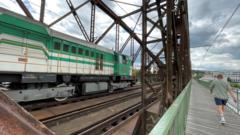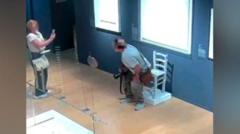The Vysehrad railway bridge, a notable 123-year-old structure in Prague, is slated for replacement, leading to a heated debate among locals and experts about cultural preservation versus modern transport necessities. The bridge forms part of the cityscape, admired alongside the Vysehrad fortress, prompting fierce opposition to its removal.
Architect Petr Tej, part of an advocacy group, strongly believes in the bridge’s significance, stating that it contributes to the iconic vistas of Prague on par with the renowned Charles Bridge. The Vysehrad Bridge Foundation, comprising international authorities in steel bridge restoration, challenges the need for dismantlement, asserting that prior assessments exaggerate the repairs needed, with claims that only 15% of the steel requires replacement.
Endorsed by UNESCO and backed by over 25,000 signatures from residents advocating restoration instead of replacement, the foundation's proposal aims to preserve the bridge while keeping train operations functional, thus alleviating both financial and infrastructural disruptions.
On the opposing side, the Railway Authority’s Pavel Paidar counters that heightened rail traffic demands make the bridge's current state unmanageable. He believes a replacement is vital for future transportation growth, proposing a modern structure that respects the original’s design yet adds essential capacity enhancements.
While plans include relocating the existing bridge to Modrany as a pedestrian and cyclist crossing, critics assert this repositioning lacks coherence with its urban history. They caution against losing Prague’s cultural essence in the pursuit of modernity, sparking a debate that questions community values towards tradition and progress. In a city known for its architectural legacy, the resolution to this conflict may ultimately fall on the shoulders of the Czech government.





















